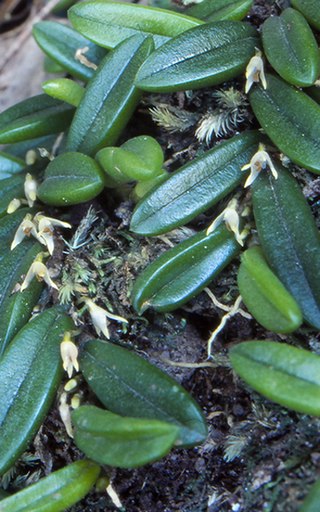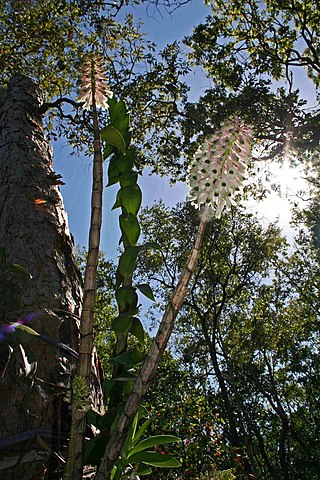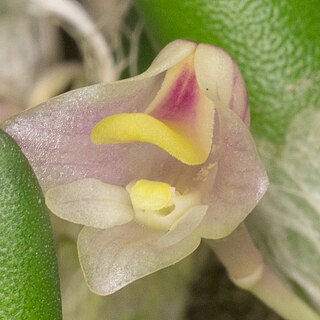
Bulbophyllum elisae, commonly known as the pineapple orchid, is a species of epiphytic or lithophytic orchid that is endemic to eastern Australia. It has crowded, wrinkled, pale green or yellowish clump-forming pseudobulbs, stiff, pale green to yellowish leaves and between three and twelve pale green to dark green flowers with a dark red to purple labellum. It usually grows in the tops of rainforest trees, on cliff faces or boulders.
Bulbophyllum minutissimum, commonly known as the red bead orchid or grain-of-wheat orchid, is a species of epiphytic or lithophytic orchid with small, flattened, reddish or green pseudobulbs, scale-like leaves and small whitish to reddish flowers with broad dar red stripes. It grows on trees and rocks, mostly in swamps and near streams in eastern Australia.
Bulbophyllum nematopodum, commonly known as the green cowl orchid, is a species of epiphytic or lithophytic orchid that has small, flask-shaped pseudobulbs pressed against the surface on which it grows. Each pseudobulb has roots at its base, a single shiny, fleshy leaf and a single cream-coloured flower with red spots on its top. It grows on trees and rocks in rainforest and is endemic to tropical North Queensland.

Bulbophyllum shepherdii, commonly known as the wheat-leaf rope orchid, is a species of epiphytic or lithophytic orchid that forms a dense mat of branching rhizomes pressed against the surface on which it grows. The pseudobulbs are well spaced along the rhizome, each with a single egg-shaped leaf and a single small, white or cream-coloured flower with yellow tips. It grows on trees and rocks in rainforest and is endemic to eastern Australia.

Dendrobium smillieae, commonly known as the bottlebrush orchid, is an epiphytic or lithophytic orchid with large, spongy pseudobulbs, thin, bright green leaves which are shed after their first year and crowded flowers in a bottlebrush-like arrangement. The flowers are white, to cream-coloured or pink and the labellum has a shiny, dark green tip. This orchid species is found in some of the Torres Strait Islands, and through Cape York Peninsula to Townsville, Queensland. It is also found in New Guinea and eastern Indonesia.

Spathoglottis paulinae, commonly known as the small purple orchid, is a plant in the orchid family and is native to New Guinea and Tropical North Queensland. It is an evergreen terrestrial orchid with crowded pseudobulbs, between four and seven large, pleated leaves and up to thirty mauve to purple flowers.

Dipodium ensifolium, commonly known as leafy hyacinth-orchid, is an orchid species that is endemic to north-east Queensland. It has sword-shaped leaves and up to twenty pink to mauve flowers with purplish spots and blotches.

Caladenia cairnsiana, commonly known as the zebra orchid, is a species of orchid endemic to the south-west of Western Australia. It is a common and widespread orchid distinguished by its red-striped labellum, and petals and lateral which are pressed against the ovary.
Genoplesium woollsii, commonly known as the dark midge-orchid, is a species of orchid endemic to New South Wales. It has a single thin, wiry leaf and in autumn has up to thirty five drooping, dark purple flowers on a flowering stem which is fused to the lower part of the leaf.

Arthrochilus irritabilis, commonly known as clubbed elbow orchid, is a flowering plant in the orchid family (Orchidaceae) and is endemic to Queensland. It has up to five leaves and up to thirty light greenish or reddish, insect-like flower with reddish, hair-like glands on its labellum. There is a single record of this species from Papua New Guinea.
Nervilia uniflora, commonly known as the red shield orchid, is a small terrestrial orchid found in northern Queensland. It has a single short-lived, pink or mauve flower. A dark green, heart-shaped leaf emerges at the base of the flowering stem after flowering.
Liparis coelogynoides, commonly known as the fairy sphinx orchid, is a plant in the orchid family and is endemic to near-coastal eastern Australia. It is an epiphytic orchid with two leaves joined at the base and that grows in clumps. Greenish white or yellowish flowers are borne on an often hanging spike. It grows on trees and cliff faces usually on ranges near the coast of northern New South Wales and southern Queensland.

Dendrobium baileyi, commonly known as the blotched gemini orchid, is an epiphytic or lithophytic orchid in the family Orchidaceae and has arching stems and flowering stems with one or two spidery, yellow flowers with dark purple spots emerging from leaf axis. It grows in tropical North Queensland, New Guinea and the Solomon Islands.

Dendrobium lichenastrum, commonly known as the common button orchid, is a species of epiphytic or lithophytic orchid endemic to far north Queensland. It has a creeping, branching rhizome surrounded by papery bracts, small egg-shaped to round, fleshy, dark green leaves and a single white, cream-coloured or pink flower with red stripes and an orange labellum.
Chiloschista phyllorhiza, commonly known as the white starfish orchid, is a species of leafless epiphytic or lithophytic orchid that forms small clumps with many radiating, flattened green roots. A large number of short-lived, crystalline white, star-shaped flowers with a yellow labellum are arranged along thin, arching flowering stems. It occurs in northern parts of Australia where it grows in rainforest, swamps and near streams.

Plectorrhiza brevilabris, commonly known as the small tangle orchid, is an epiphytic or lithophytic orchid endemic to Australia. It has many coarse, wiry roots, between three and nine bright green leaves and up to twenty green, star-shaped flowers with reddish brown markings and a white patch on the labellum. It grows in rainforest on trees, shrubs and occasionally on rocks and occurs on the near coastal ranges of eastern Queensland.

Pomatocalpa macphersonii, commonly known as the blotched bladder orchid, is an epiphytic or lithophytic orchid with thick, cord-like roots, between two and eight dark green, leathery leaves and up to thirty cup-shaped, yellow flowers with red blotches and a white labellum with red blotches. It usually grows on rainforest trees and is found in New Guinea and tropical North Queensland, Australia.

Sarcochilus ceciliae, commonly known as fairy bells, is a lithophytic orchid endemic to eastern Australia. It has up to ten channelled, spotted linear leaves and up to twenty pink flowers with a hairy labellum.

Sarcochilus hillii, commonly known as myrtle bells, is a small epiphytic orchid native to eastern Australia and New Caledonia. It has up to ten drooping, quill-shaped leaves and up to ten frosty white or pink flowers that have a hairy labellum with purple stripes.
Liparis angustilabris, commonly known as the twisted sphinx orchid, is a plant in the orchid family and is endemic to northern Queensland. It is an epiphytic or lithophytic orchid with tapered pseudobulbs, each with a single linear leaf and up to thirty five pale green to yellowish flowers that have twisted sepals and petals. This orchid grows on trees and rocks in tropical North Queensland.












